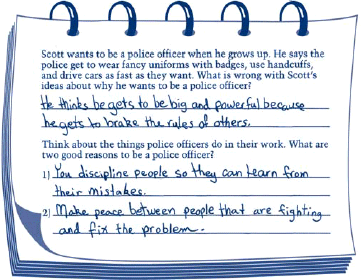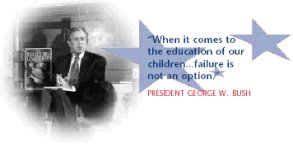 | |||||||||
| |||||||||
|
|||||||||
One-Year Anniversary of NCLB Highlights Year's Successes
An Ideal Solution for Change
Close-Up: No Child Left Behind—Character Education
Tips for Parents
New Guidebook—Engaging Students in Service
One-Year Anniversary of NCLB Highlights Year's Successes
On January 8—exactly one year following the signing of the No Child Left Behind (NCLB) Act into law—U.S. Secretary of Education Rod Paige joined President George W. Bush, school superintendents and principals, chief state school officers, several members of Congress and other education leaders in celebrating the anniversary of the historic legislation.
". . . [I]t's been a good year," said Paige. "Now all of our hard work has paid off, and we're off to a start, but only a start. The finish is when every American child has a great education."
President Bush and Secretary Paige marked the one-year anniversary by highlighting eight schools from across the country that are making gains in student achievement and five states whose accountability plans have been approved by the Department of Education.
At the White House event, the president announced his FY 2004 budget proposal for increasing funding for the Reading First and Early Reading First programs by $75 million more than last year, bringing the total to more than $1.1 billion. Using scientifically proven methods of instruction, these programs help children learn to read by the end of third grade and improve pre-reading skills in pre-school.
From FY 2000 to 2002, federal funding for programs in No Child Left Behind increased by 49 percent, with states and local school districts receiving more than $22 billion in this school year alone to implement the act's provisions.
For a full script of remarks given by the president and secretary, as well as a recap of the year's results following the enactment of NCLB, please visit www.ed.gov/PressReleases/01-2003/01082003a.html.
An Ideal Solution for Change
By S. Patrick McEvoy, St. Louis, Mo.
At Maplewood-Richmond Heights (MRH) Senior High School, character education has made an enormous impact on the school environment, and it continues to evolve. It influences everything we do at our school and has become a common language that informs our school culture.
When I started as vice principal at MRH six years ago, our school was struggling to survive. There were few, if any, building procedures in place, and discipline was sorely lacking. My first weeks were spent trying to handle serious non-academic problems. Students arrived at school with no schedules, and disorder continually threatened to overwhelm us. Student behaviors caused me to think that I had come to a place that I never imagined existed in public education. During my entire first year, I wondered why any of our dedicated staff stayed and how they survived.
When I started looking for a solution to the myriad problems our school faced, I decided to use a character education program to spearhead the creation of a new school culture. I decided that personalized services and relationships with students would drive our character education program beyond "word-of-the-month" posters or intercom announcements. Gradually the students took over much of the leadership and work involved. They now meet regularly to plan curriculum and activities, teach lessons, and make decisions concerning the direction of the program. Character education has transformed our school into one that bears little resemblance to the school of six years ago.
Although our demographics remain the same, our school culture does not. Statistics indicate that we have completely changed the climate of our high school. Ninety-seven percent of last year's senior class reported that their high school is a safe and well-disciplined environment. Out-of-school suspension days decreased by 75 percent from 1998 to 2002. Attendance has steadily increased, from 79 percent in the 1997-98 school year to 92 percent in 2001-02. The dropout rate has significantly decreased, from 15 percent in 1997-98 to 2.4 percent in 2001-02. Our improvement clearly indicates that character can be taught, learned and nurtured.
| "Some people think of education in terms of the 'Three R's'—reading, writing and 'rithmetic—but another 'R' is essential: responsibility." —First Lady Laura Bush, in a speech given at the White House Conference on Character and Community, June 19, 2002. |
A school once plagued with gang fighting and school violence is a quiet and peaceful environment, free of these distractions. The number of students attending two- or four-year colleges has risen steadily during the past four years. State-mandated testing shows signs of improvement in math, social studies and English. Our ACT scores have improved, and we have increased the number of students taking this test as well as those scoring at or above the national norms.
Earlier this school year we were honored by a visit from First Lady Laura Bush. She came to MRH to host the White House Conference on Character and Community, where she participated in a panel discussion on character education with several of our students.
All of this was not possible six years ago, before character education helped us articulate who we were, where we wanted to be and how we wanted to support each other along the journey. In keeping with the principles of No Child Left Behind, our high school no longer accepts failure. We have shown that you can change the culture, academic environment and instructional practices in a struggling urban/suburban high school.
S. Patrick McEvoy is the principal of Maplewood-Richmond Heights Senior High School in the St. Louis, Mo., area. Recently, he served as a panelist for the White House Conference on Character and Community, speaking about the benefits of solid character education in high schools.
Close-Up On: No Child Left Behind—Character Education
The No Child Left Behind Act of 2001 sets high standards not only for developing students' academic skills but also for enriching their values. As President Bush said in his speech last year at the White House Conference on Character and Community, "Our children must learn to make a living, but even more, they must learn how to live . . . Schools should be safe and orderly; they should be decent and drug-free; and they should teach character by expecting character."
67 percent of a national sample of fourth-graders received a rating of "Acceptable" or better when asked the following question: Source: National Center for Education Statistics, The NAEP 1998 Civics Report Card Highlights, Grade 4 Sample Questions and Responses.
Source: National Center for Education Statistics, The NAEP 1998 Civics Report Card Highlights, Grade 4 Sample Questions and Responses. |
Title V of the law—which focuses on efforts promoting informed parental choice and innovative programs—recognizes parents, schools and communities as allies in the moral education of the nation's children. Through the Partnerships in Character Education program (Part D, Subpart 3), the Department of Education will provide grants to design and put into practice instruction about aspects of character such as citizenship, justice, respect, responsibility, trustworthiness, giving and caring.
Among the key requirements of this discretionary grant program is the extent of parent involvement: states and other grantees must consider the views of parents and students in selecting a character education program as part of their ongoing participation. Parental and community involvement is one of several factors for evaluating the effectiveness of the character education program.
Another requirement, which is distinctive from previous provisions of the program, is the element of research. Grantees must demonstrate that their character education programs have "clear objectives that are based on scientifically based research."
Furthermore, the adopted program must be integrated into the school's curriculum and teaching methods. Any curricula, materials and other activities developed under the grant must be linked with education reform efforts and state content standards.
For more information, call 1-800-USA-LEARN.
Tips for Parents
Rearing children of character demands time and attention. While having children may be "doing what comes naturally," being a good parent is much more complicated. Here are five tips to help your children build strong character:
- Be a good example. Face it: human beings learn primarily through modeling. In fact, you can't avoid being an example to your children, whether good or bad. Being a good example, then, is probably your most important job.
- Develop an ear and an eye for what your children are absorbing. Books, songs, TV, the Internet and films are continually delivering messages—moral and immoral—to our children. As parents we must control the flow of ideas and images that are influencing our children.
- Get deeply involved in your child's school life. Helping our children become good students is another way of helping them acquire the habits that build strong character.
- Make a big deal out of the family meal. Manners, rules and values are subtly absorbed over the dinner table. Family mealtime should communicate and sustain ideals that children will draw on throughout their lives.
- Do not reduce character education to words alone. We gain virtue through practice. Parents should help children by promoting moral action through self-discipline, good work habits, kind and considerate behavior to others, and community service. The bottom line in character development is behavior—their behavior and yours.
New Guidebook! Engaging Students in Service
Calling on America's students to volunteer their time and talents, President Bush, in a radio address to the nation at the start of the school year, introduced a new guidebook to help engage young people in a lifelong habit of service and develop the habits of civic participation, responsibility and service essential to American democratic life.
Students in Service to America offers research and resources for planning service activities and service-learning programs to the adults who work with young people in schools, after-school programs and through community groups and organizations. The 31-page guidebook provides—
- Ten steps for bringing service to the classroom;
- Examples of service-learning in action;
- Tools for designing and implementing service programs;
- A list of national organizations that offer funding and personnel assistance; and
- A list of recognition programs that award students with volunteer experience.
For an online copy, please visit www.studentsinservicetoamerica.org.
Credits
U.S. Department of Education
The Achiever is published by the Office of Intergovernmental and Interagency Affairs, U.S. Department of Education (ED).
Secretary of Education
Rod Paige
Assistant Secretary
Laurie M. Rich
Senior Director
John McGrath
Executive Editor
Sarah Pfeifer
Editor
Nicole Ashby
Contributing Writer
S. Patrick McEvoy
Contributor
Linda McKay
Designer
Jason Salas Design
Questions or comments:
Editor
The Achiever
U.S. Department of Education
400 Maryland Avenue, S.W.
Room 5E217
Washington, DC 20202
Fax: 202-205-0676
NoChildLeftBehind@ed.gov
Electronic subscriptions and address changes: NoChildLeftBehind@ed.gov
Paper Subscriptions and address changes:
ED Pubs
P.O. Box 1398
Jessup, MD 20794
1-877-4ED-PUBS (433-7827)
edpubs@inet.ed.gov
Information on ED programs, publications and initiatives:
Information Resource Center
U.S. Department of Education
400 Maryland Avenue, S.W.
Washington, DC 20202
1-800-USA-LEARN (872-5327)
usa_learn@ed.gov www.ed.gov/about/offices/list/oiia/irc.html
The Achiever contains news and information about public and private organizations for the reader's information. Inclusion does not constitute an endorsement by the U.S. Department of Education of any products or services offered or views expressed.
Unsubscribe
To unsubscribe from The Achiever:
- Send email to listproc@inet.ed.gov
- Write in the body of the message: unsub nochildleftbehind

|
|
|
|||||||||||
| |
||||||||||||
Last Modified: 11/06/2006

